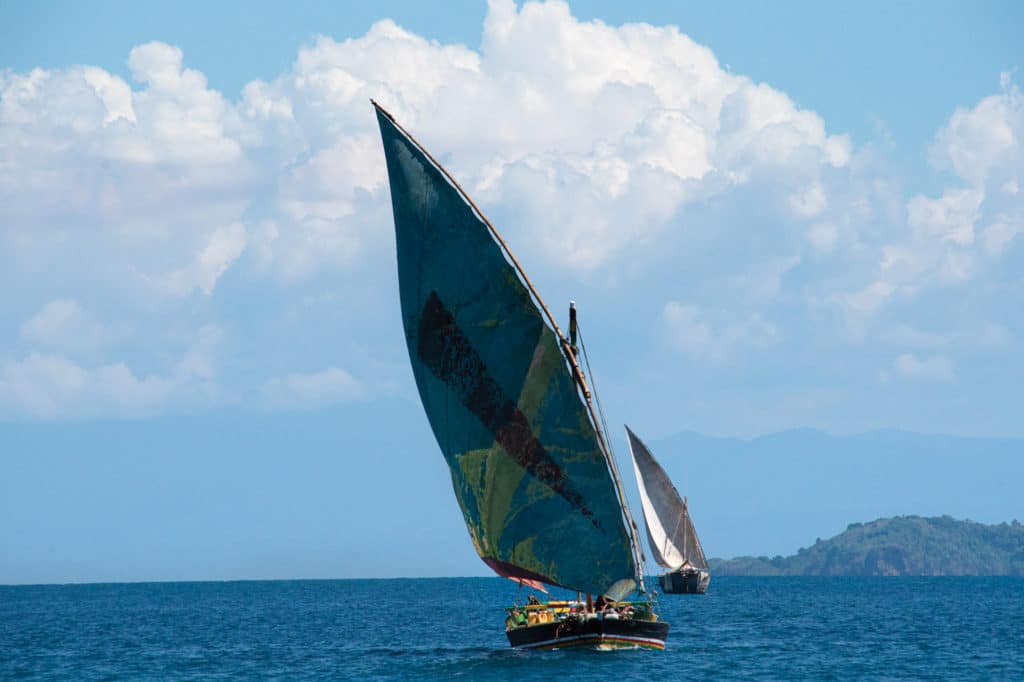
“Plongée,” the man in the canoe said to me.
I flipped through the pages of my French sailor’s dictionary, hoping to stumble upon an explanation of what this man wanted. It had been years since we were in a French-speaking territory, and I was woefully unprepared to figure out he was talking about diving.
But I was motivated. In his small little dugout canoe was my prize for a successful negotiation: two large spiny lobsters and a moderate-size grouper. We had stumbled through delivery negotiations the day before.
“Langoustine?” he had asked me.
“Oui!”
He held his hands up: big or small?
“Gros.”
And then fingers: one, two, three?
“Deux.”
He nodded and sat in his canoe.
“Poisson?” I asked him.
And there we were, 12 hours later, and all that stood between me and a seafood extravaganza was my horrible French. I had no ariary, the local currency, and when I offered euros, he shook his head.
I stepped inside our 44-foot catamaran, Starry Horizons, a Fountaine Pajot Helia, and pulled out a few items from a designated “trading” bag. Prior to our arrival in Madagascar, cruising friends who had come before had advised us that the Malagasy people prefer trade over commerce.
I handed the man a few items, which he looked over—some he kept, some he gave back. “Plongée,” he said again, tapping an open hand on the surface of the water.
Finally, I pulled out a snorkel mask, and he became excited. With a big smile, he accepted the mask and handed me over his catch.
I was proud of myself; it was our first morning in Madagascar, and I’d just had a successful interaction with a local and acquired some delicious seafood.
My husband, David, and I had come over the top of the island from the Seychelles, a passage that had taken us a little less than four days, and the previous night had been a whopper. Cap d’Ambre had proved to be challenging, with the swells and currents hitting us in the black of night. Starry Horizons climbed up waves, barely making any speed over the ground, before surfing down the other side at 10 knots.
We’d hastily thrown on both engines and cut toward the shore—land that we couldn’t see under the cover of clouds and a new moon. The chop and wind lasted longer than we thought it would, even while trying to tuck in along the shore to get under its lee. Finally, we dropped anchor at Nosy Mitsio, a small island off the northwest coast, where we were well-protected and not alone; three other cruising boats were in the anchorage just off the village.
This was our first true glimpse of Madagascar. It was dry and brown with sparse vegetation, and cows—or maybe zebu, the horned and humped cattle— wandered along the shore.
Since we hadn’t officially cleared in yet, we rested and moved on quickly, taking a day to sail down to Nosy Be, the hub for sailing activity in Madagascar, and one of the busiest tourist centers in the country.
Madagascar, once known at the Malagasy Republic, has always intrigued me. Even before other sailors had told me that the island nation was on their list of favorite places, I pictured it as an opportunity to explore a world completely different from my own. We were on the home stretch of our own circumnavigation, and had been to many places where the cultures were vastly different from ours. But these places didn’t seem as authentic. For instance, tourists flock to Thailand by the millions (35 million in 2017), whereas Madagascar, only slightly larger than Thailand, saw fewer than 100,000 tourists in the same year.
There’s a reason: It’s hard to get there, and once you reach the former French colony, travel within the country is a challenge too. A majority of the roads (some estimate 90 percent) are unpaved and wash out during the rainy season. Trains and buses are cheap but cramped and unreliable.
Travelers can overcome these difficulties by visiting Nosy Be, however. It’s a small island on the northwest coast. Direct flights arrive from Europe, bypassing the capital, Antananarivo, and there are a variety of activities available when you get there, whether as a tourist or cruiser.
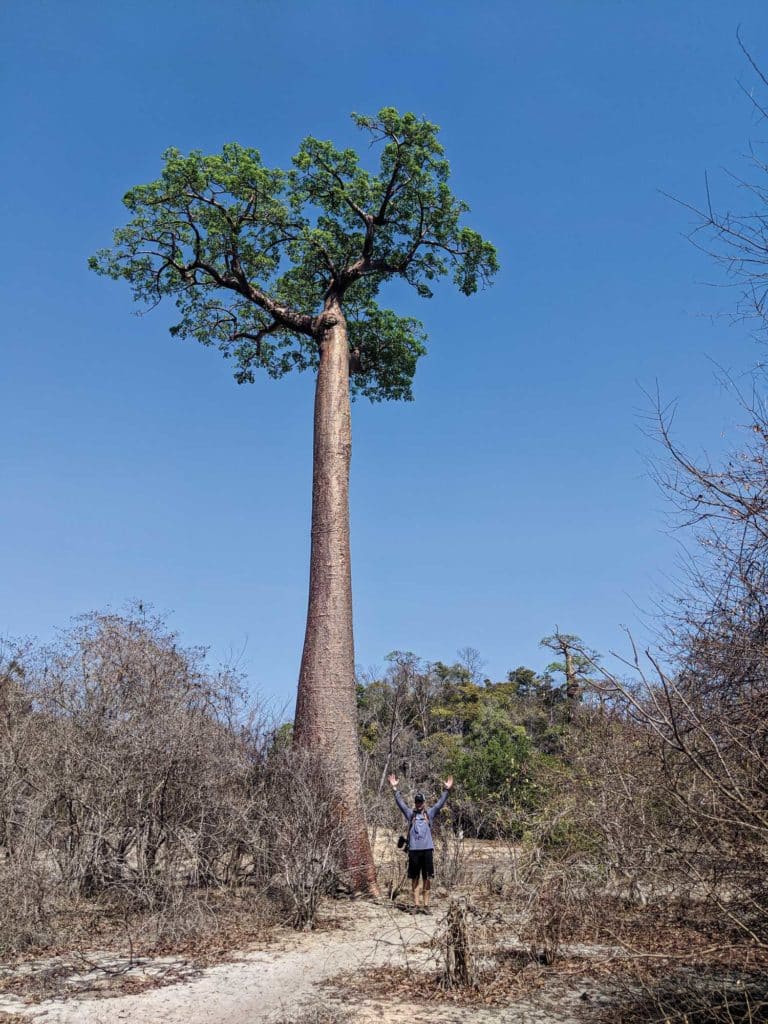
Touring the Town
We arrived at Hell-Ville, the capital of Nosy Be, with vague advice from friends to “find Jimmy with the red hat.” And despite the thick traffic of tour boats, ferries and traditional Malagasy dhow fishing boats, we did find him. It turns out that he’s at the dock every morning keeping an eye out for the few sailboats that wander into Hell-Ville’s unattractive port to complete their formalities.
Jimmy spent all day with us. We visited the required offices, paid fees and filled out paperwork. He took us to the ATM, where we stuffed our wallets full of 20,000 ariary bills, each the equivalent of $5 back home in the US. With our newfound cash, we bought a SIM card, connected to the internet, and then hired a tuk-tuk to take us shopping at a store called Shampion, which was stuffed with French imports. I had thought that Madagascar would be one of the harder places to provision based on its economy, but happily, I was wrong; the shelves were full of Western foods.
Besides Bio- and Carrefour-branded items, I found Tsara Malagasy dark chocolate. At no other time in my life have I experienced such a startling departure from a familiar taste. Malagasy chocolate is rich and fruity, made of a bean variety rarely grown elsewhere.
Next, Jimmy took us to the Hell-Ville Market, a building stuffed to the gills with local food. I bought small shelled peanuts, roasted and salted to perfection; smoked and dried bananas that are ubiquitous to French territories; and giant, succulent Malagasy tiger shrimp, caught that morning by the local fishermen. (I avoided the red hunks of zebu meat that were sitting out and covered with flies.)
When our day with Jimmy was done, we’d paid officials over $200 to visit Nosy Be. Without negotiating, we also paid Jimmy his requested fee, a paltry amount for spending the entire day with us. We’d done the same with our tuk-tuk driver and at each stall at the market. The prices were low, the economic gap wide, and I gratefully handed over the fees.
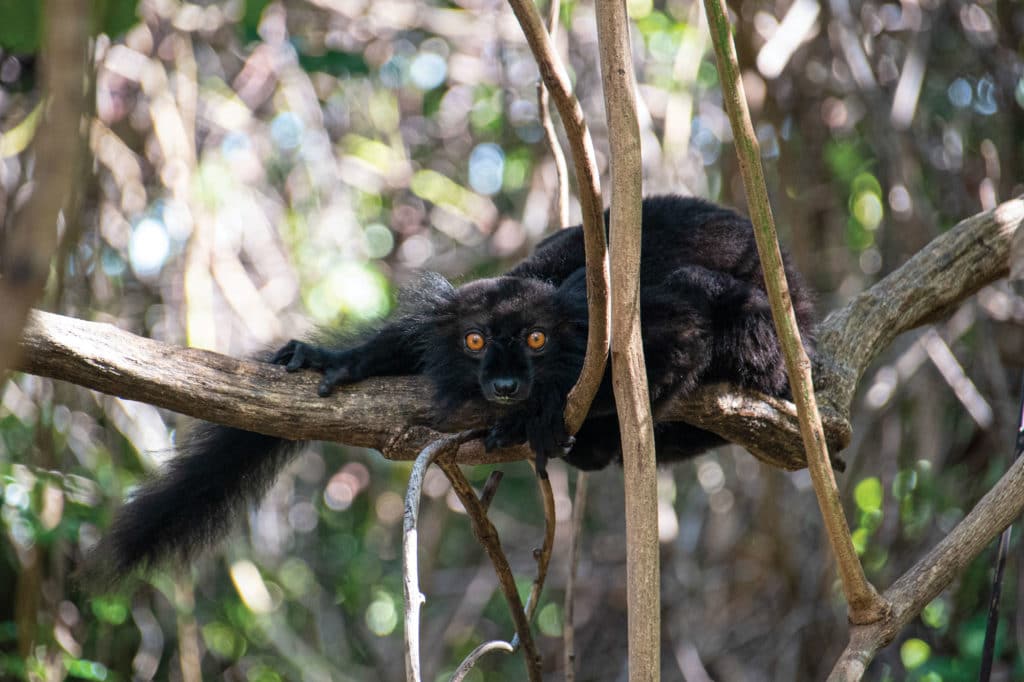
Settling In
Sailors in Madagascar learn to time their days with the breeze: offshore in the morning, onshore in the afternoon. In between, it’s either dead-calm or the breeze is light. We chose afternoon to move to Nosy Komba, an island 6 miles southeast of Hell-Ville. We raised sails and coasted along in 7 knots of wind, dodging the traffic in and out of Hell-Ville. By sunset, we were anchored on the northeast side of the island, fairly unprotected from the swell but next to our buddy boat and friends Kimi and Trevor, who had been in Madagascar for more than a month.
In the morning, the four of us went to the park-ranger office in the village and hired a guide to take us on an ambitious trip to the top of the island. Our ranger, John, grabbed a fistful of bananas before we started the climb.
As we walked, John told us about the local village, and we passed through stalls where women sell hand-carved wooden lemurs or traditionally woven linens. Most were unattended because it was still early.
John stopped us. “Look,” he said, pointing to the tree. “We have company.”
Climbing through the branches were lemurs. The females—the bosses—were brown; the males, black.
“Stand right here,” he directed me, “and turn around.”
A moment later, I was startled when a small weight hit my shoulder from behind. My cheek brushed against delicate fur, and out of the corner of my eye, I saw an inquisitive face and a paw reaching out for John’s offered banana.
We all took turns standing by the tree as lemurs leaped onto our heads, shoulders or backs, and climbed down our arms. They were lighter than we expected, and softer. Several of the females had babies clinging to their bellies, with large round eyes staring at us.
When the bananas were gone, so were the lemurs.
“In the rainy season, when the fruits are ripe, they don’t come to feed with us. There’s too much good food for them in the trees,” John told us as we continued on up the path.
Then John stopped us again five minutes later. He pointed to a small tree just to the left of the trail, and I strained my eyes trying to see what he saw. As happens when viewing an autostereogram, my eyes adjusted, and a chameleon appeared in the leaves before me. And then I saw them everywhere. The others saw them too, and we watched their tall but extremely narrow bodies as they slowly, haltingly climbed the branches.
As we climbed, we saw a ground boa, various lizards and insects, and we passed a religious memorial and cemetery for French soldiers. At the top, overlooking Nosy Be, we found a bamboo shack on a manicured plot of land. The lawn was dotted with picnic tables and the view was spectacular, the flat-calm waters around the islands reflected the clouds above. At the shack, a young man sold beverages. John ordered a hot lemongrass tea, while the rest of us asked for cold lemon juice; Trevor got his with a shot of local rum.
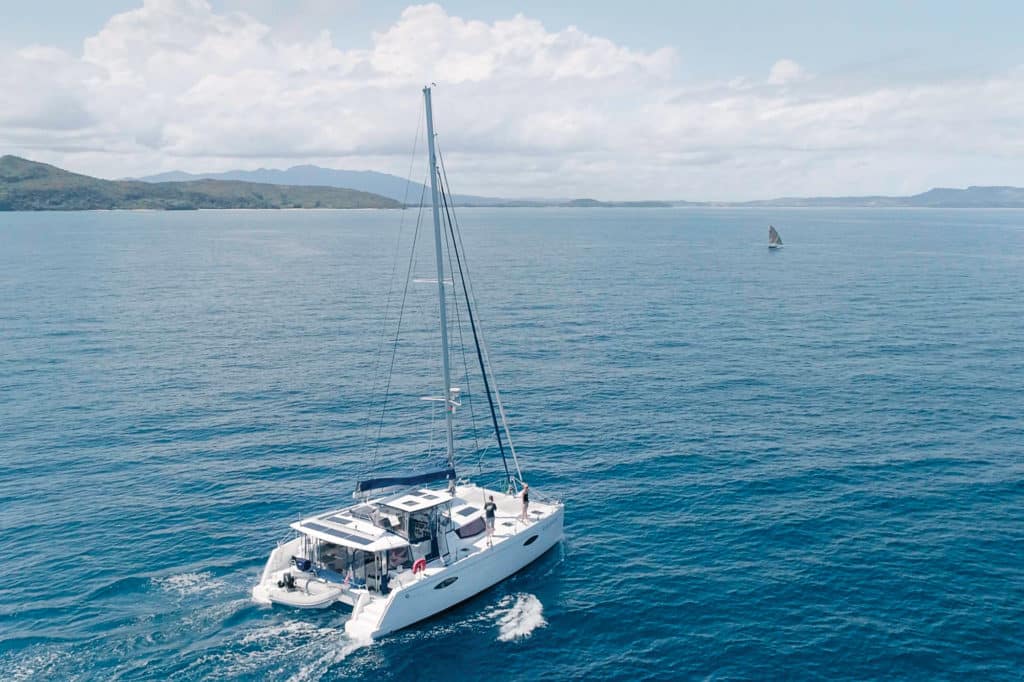
Dhows and Dugouts
Back in Nosy Be, we anchored in Crater Bay off the yacht club. In the morning, we sipped our wake-up beverages and watched the local fishermen. All day, every day, they paddled by in dugout canoes to lay out fishing nets before hauling up shimmering silver fish by the hundreds. Meanwhile, traditional Malagasy dhows glided around us, with their patched sails making use of the light winds.
“What exactly are we doing on the tour today?” David asked me.
I shrugged. “I’m not sure. Lokobe Park, I think?” It’s the top attraction in Nosy Be, according to Trip Advisor, which meant we could expect an adventure.
Our guide, Achim, picked us and Kimi up at the yacht club, and we headed off to the other side of the island. The road was mostly unpaved, and our big van bumped along, passing men and zebu plowing fields together, and ylang-ylang trees bowing down in vast groves.
In Ambatozavary, a small village, Achim changed out our driver for one of the men from the village, a local guide named Joe. It seemed as though the whole village was there, and everyone walked down to the beach, through the mangroves and mud, to where outrigger canoes were anchored. The local school children stripped down, swam out and brought in the boats.
Joe and Achim instructed us—the only tourists—to climb into a canoe, and Achim handed us a paddle. We set off before the other boats were loaded.
After 20 minutes, I asked Achim, “How far are we paddling?”
He pointed vaguely out over the horizon. “Across the channel.” The next island was more than 10 miles away, and I was glad I’d kept up a workout routine while sailing.
We took turns paddling, but Joe and Achim were our ringers, rowing strongly and steering us around the reefs. Before long, boats started to fly by; not just the outrigger canoes we’d left behind, but also small powerboats with tourists. Some even towed canoes behind them.
To our relief, our guides steered our canoe to the beach after about 45 minutes—our destination was not the distant island. We disembarked and set about exploring the Lokobe National Park. Joe led us on a walk through the forest, where we spotted tree boas, leaf-tailed geckos and more lemurs. These lemurs were feeding on jackfruit, sticking their heads into the insides of the fruit from beneath and feasting.
When we returned, lunch—a variety of Malagasy dishes—was prepared: green mango salad, crab curry, and bananas cooked in coconut milk. When the meal was over, we were given time to wander through nearby handicraft stalls selling ylang-ylang oil, carved wooden lemurs and traditional woven linens. Then it was back to the outrigger for our paddle back.
To finish our day, we took the easy walk to the top of Mont Passot and watched the sun set over the crater lakes. Sunsets in Madagascar were exceptionally beautiful. The air quality was clear, and we could see mountains 50 miles away as the sun turned a deep red and dropped behind the islands.
Many Stars
We had one last adventure in store for us in Nosy Be. With our other cruising friends Carlos and Linda, we hired a dive shop to take us out to look for whale sharks. David and I have tried, unsuccessfully, to swim with them for years in various places around the world, and this time, we were exceptionally lucky. Our captain pointed the motorized outrigger toward open water, and a young boy climbed up on the bow to spot. The boy scanned the surface of the water looking for schools of jumping tuna. Whale sharks don’t eat tuna, but the tuna feed on smaller fish, which, in turn, feed on plankton. Where you find leaping tuna chasing their food, you’ll find whale sharks too, basking and sweeping up the plankton in their wide mouths.
We spotted the first school of tuna and approached. A whale shark was just below the surface of the water, and with the crystal-clear view, we could see his constellation-riddled hide. After all, the Malagasy name for whale sharks is marokintana, which translates to “many stars.”
“Go,” our guide said quietly, and we slipped into the water less elegantly than we’d have liked. The shark floated diagonally, its mouth on the surface while surrounded by beams of sunlight. It tolerated a few moments of our attention but then moved on.
Our guides had a tough job trying to predict where the whale sharks would be found. They tried to drop us in the water where we wouldn’t disturb the fish too much, but also near where they expected the whale shark to swim in order to maximize our time with each one. By the end of the day, we’d been in and out of the water dozens of times, and some whale sharks approached close to inspect us, while others veered off quickly. We were euphoric, having finally taken that amazing swim we’d dreamed of for years.
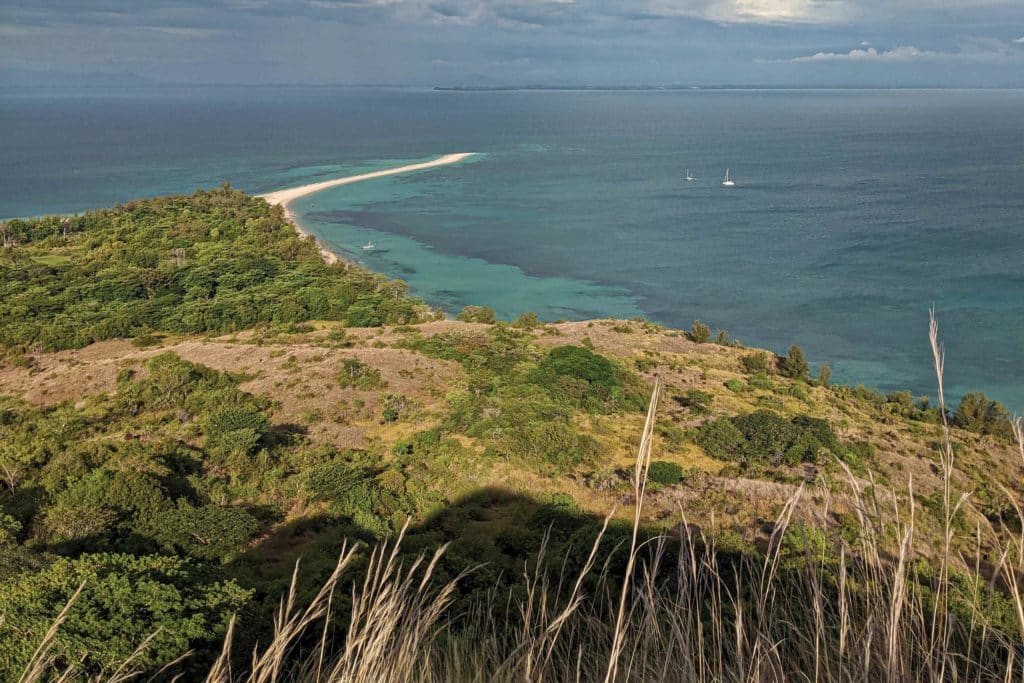
Sailing On
Our time in Nosy Be had come to an end. We had an ambitious few months ahead of us: crossing the Mozambique Channel and sailing around South Africa. As do most cruisers, we made our way down the west coast of the big island, ducking into protected waters and making progress toward the narrowest part of the Mozambique Channel.
The sailing was an exercise in frustration. The morning wind was light and from forward of the beam. It died midday, then picked back up again from the opposite direction.
When we arrived in Honey River, only our friends Carlos and Linda were there, but as the day progressed, the charter boats filed in. Still, there was plenty of room for everyone.
A small village sits on the north shore, and it was possible to buy the namesake honey there. I went ashore with Linda, who speaks French—a good thing because the locals didn’t speak English. At one shop, we agreed to the price, and the woman started to fill our jars with honey from a jerry can. Around her sat a collection of 1.4-liter plastic bottles of honey, which I belatedly realized were a better price. But our deal had been struck.
She poured the sweet liquid into my jar through a sieve, and when it was full, she lifted the sieve and licked the drop of honey off the bottom before placing it in a bin. There were certainly no health inspectors around!
Linda and I visited the library and donated school supplies. The kids swarmed around us. They are used to cruisers and charter guests popping in with gifts, and they have learned to be persistent. They asked for books, candies, even the hats and sunglasses off our heads, and we eventually had to shoo them away. Honey bought, donations made and village explored, we returned to our boats.
Our next stop, with Carlos and Linda following, was the beautiful island of Antanimora. This is typically the last stop for charters, and for some reason, when we arrived in the afternoon, the vacationers were all anchored on the north side of the little sand spit that stretches out at low tide. The wind blows from the north later in the day, so they were experiencing a rigorous chop. We ducked under the south side of the spit, and even when the wind shifted in the morning, the anchorage wasn’t too bad.
After breakfast, Linda and I set off on a girls-only adventure. The island has a prominent hill, and, we thought, surely there would be a trail. We walked through the village, Linda asking in French about a path up it. The Malagasy people looked at us as though we were crazy. Finally, we met an older gentleman, who beckoned to us to follow him. We were joined by two younger men, who introduced themselves as the crew of one of the fishing boats. Their English was excellent, and our local guide’s English was good enough for me as he led us up a beaten path, pointing out medicinal plants and an ancient burial site.
After 90 minutes, slipping and sliding on the tall grass, we made it to the top. Below us stretched the whole island: the sand spit pointing straight out, and our two boats bobbing in the anchorage to our right. I pulled out my phone, and the five of us made a short video, in which our guide enthusiastically whooped and hollered for our achievement.
Back at the dinghy, he graciously asked for a tip, which we gave him, and then he explained that the village needed medicine, especially for digestion troubles. I had some over-the-counter pills in my small first-aid kit, and he was thankful when I pressed them into his hands.
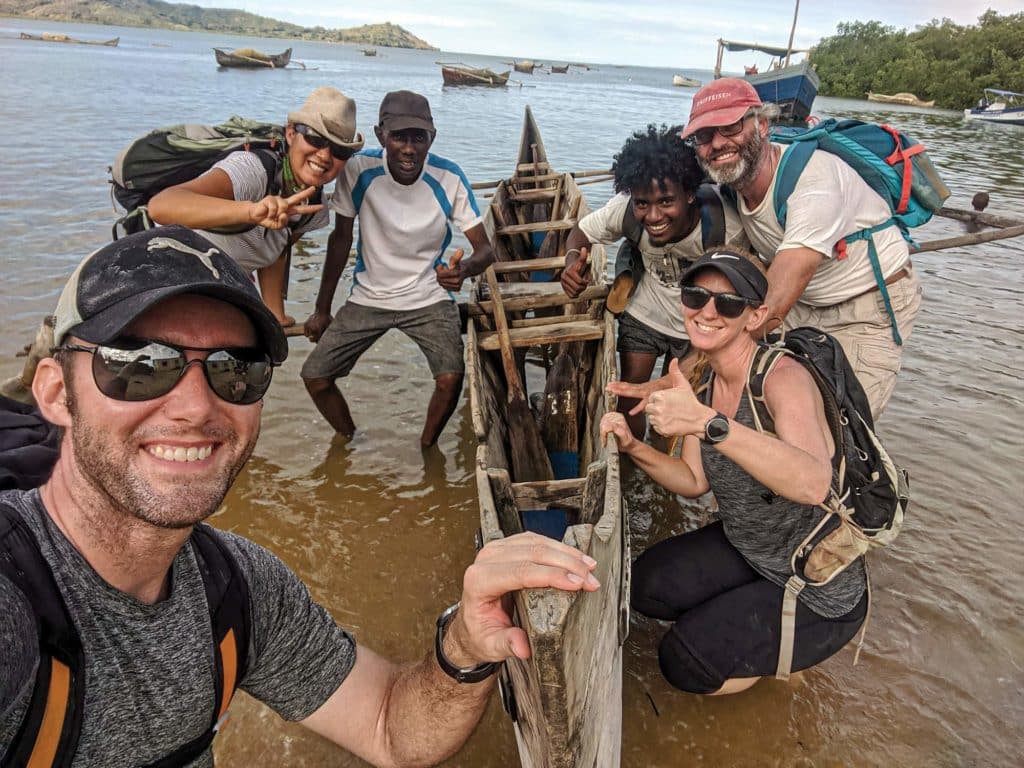
Off to See the Giants
We departed the next morning for our last big stop in Madagascar. We sadly said goodbye to Carlos and Linda, and spent two days sailing to Moramba Bay, a popular cruiser hangout. The river had a narrow entrance that feeds into a big natural harbor, wide enough to fit a dozen boats, but mostly we had it to ourselves.
Throughout the day, several dugout canoes approached us, offering to trade limes and bananas for milk, clothes or medicine. But the draw to Moramba Bay for sailors is access to another famous Malagasy resident: the baobab tree. From our boat we could already see dozens. Following our friends’ directions, we drove our dinghy as close to shore as we could, anchored, and slogged through the calf-high water and mud to the beach, where we followed trails and found ourselves standing among the giants. The baobabs are distinctive, with their wide trunks devoid of branches for hundreds of feet before a cluster of foliage at the top.
We stayed for days, and when we departed Moramba Bay, it was with trepidation of the many trials that lay ahead. South of us, there were few protected anchorages, and then the treacherous Mozambique Channel. And behind us, we were leaving a country so different from our own, but one filled with opportunities we would have never found elsewhere.
Chartering in Madagascar
Chartering in Madagascar is a tiny industry, but exploring Nosy Be on a charter boat can be greatly rewarding. There are a limited number of boats in the charter market, meaning guests can find themselves completely alone if they desire.
The charter companies are based out of the Yacht Club De Nosy Be in Crater Bay. The marina is the only place to plug into electricity and top up water tanks. Provisioning from Crater Bay is best at Leader Price, a 30-minute drive from the marina, though local fruits and vegetables are freshest at the roadside stalls or in Hell-Ville at the market.
The peak time to charter is winter—May through October—when the temperature is cooler and the weather more consistent. The summer is monsoon season, and rainstorms become more frequent while the temperature peaks. Cyclones are active from December to March.
Various itineraries are available, from four to 14 days. Anchoring is easy, and winds are often light, making for comfortable, lazy sailing. The four-day itinerary covers the nearby Mitisio Islands, just north of Nosy Be. Longer itineraries include much of our route sailing south down the coast.
The spectacular wildlife, above and below the water, plus the friendly people and stunning geography will make a charter in Madagascar the memory of a lifetime.
Charter companies operating in Nosy Be include:
Dream Yacht Charters (dreamyachtcharters.com)
East Africa Yacht Charters (eastafricayachtcharters.com)
Madavoile (madavoile.com)
Ulysse Explorer (ulyssexplorer.com)
Amy Alton and her husband, David, finished their circumnavigation in March 2020. Her stories of adventure and advice are available at outchasingstars.com.








